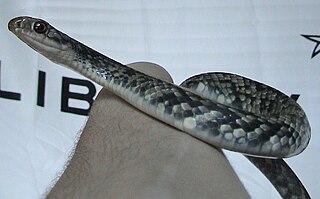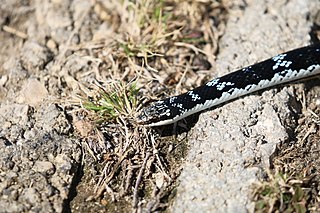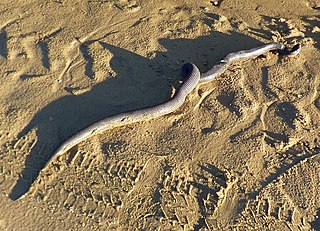
Pantherophis obsoletus, also known commonly as the western rat snake, black rat snake, pilot black snake, or simply black snake, is a nonvenomous species of snake in the family Colubridae. The species is native to central North America. There are no subspecies that are recognized as being valid. Its color variations include the Texas rat snake. Along with other snakes of the eastern United States, like the eastern indigo snake and the eastern racer, it is called “black snake”.
François Marie Daudin was a French zoologist.

Clelia is a genus of snakes, one of three genera containg species with the common name mussurana or musurana. Clelia is a genus of large snakes in the subfamily Dipsadidae of the family Colubridae. The genus is native to Central America and South America, and species of Clelia are found from southern Mexico to Brazil. They specialize in ophiophagy, i.e., they attack and eat other snakes. Seven species are recognized as being valid. They have other popular names in various countries, such as zopilota in Central America and cribo on some Caribbean islands.

Spilotes sulphureus, commonly known as the yellow-bellied hissing snake or Amazon puffing snake, is a species of venomous snake in the family Colubridae. It is widely distributed throughout South America, as well as the Caribbean island of Trinidad.

Mastigodryas boddaerti, commonly known as Boddaert's tropical racer, is a species of snake in the family Colubridae. The species is native to tropical South America including Trinidad and Tobago.

Indotyphlops braminus, commonly known as the brahminy blind snake and other names, is a non-venomous blind snake species, found mostly in Africa and Asia, and has been introduced in many other parts of the world. It is a completely fossorial reptile, with habits and appearance similar to an earthworm, for which it is often mistaken, although close examination reveals tiny scales and eyes rather than the annular segments characteristic of a true earthworm. The species is parthenogenetic and all known specimens have been female. The specific name is a Latinized form of the word Brahmin. No subspecies are currently recognized as being valid.

The trinket snake, also known commonly as the common trinket snake, is a species of nonvenomous constricting snake in the family Colubridae. The species is native to southern Central Asia.

The eastern racer, or North American racer, is a species of nonvenomous snake in the family Colubridae. The species is endemic to North America and Central America. Eleven subspecies, including the nominotypical subspecies, are recognized, which as a group are commonly referred to as the eastern racers. The species is monotypic in the genus Coluber.

The banded water snake or southern water snake is a species of mostly aquatic, nonvenomous, colubrid snakes most commonly found in the Midwest, Southeastern United States.

Coronella girondica, commonly known as the southern smooth snake or Riccioli's snake, is a species of harmless snake in the family Colubridae. The species is endemic to southern Europe and northern Africa. No subspecies are recognized as being valid.
Shaw's dark ground snake, also known commonly as Shaw's black-backed snake, and in Spanish as candelilla, guarda caminos, and reinita cazadora, is a species of snake in the family Colubridae. The species is native to northern South America.

Oxyrhopus melanogenys, commonly known as Tschudi's false coral snake, is a colubrid snake species found in the northern part of South America.
Clelia scytalina, commonly known as the Mexican snake eater or zopilota de altura, is a species of snake in the family Colubridae. The species is endemic to the New World.

Uromacer catesbyi, also known commonly as the blunt-headed Hispaniolan vine snake and Catesby's pointed snake, is a species of snake in the family Colubridae. The species is endemic to the island of Hispaniola.
Uromacer frenatus, the slender Hispaniolan vine snake or island pointed snake, is a species of snake in the family Colubridae. The species is endemic to Hispaniola in the West Indies.

Mussurana is a genus of snakes in the family Colubridae. The genus is endemic to South America.

Mussurana bicolor, the two-colored mussurana, is a species of snake in the family Colubridae. The species is native to southern South America.

Caraiba is a monotypic genus of snakes in the family Colubridae. The genus contains the sole species Caraiba andreae, also known commonly as the black and white racer or the Cuban lesser racer, which is endemic to Cuba. There are six recognized subspecies.

Chilabothrus strigilatus, also known commonly as the Bahamian boa, is a species of snake in the family Boidae. The species is endemic to the Bahamas. There are five recognized subspecies.

Boiruna maculata, also known commonly as a mussurana, is a species of snake in the subfamily Dipsadinae of the family Colubridae. The species is native to South America.


















